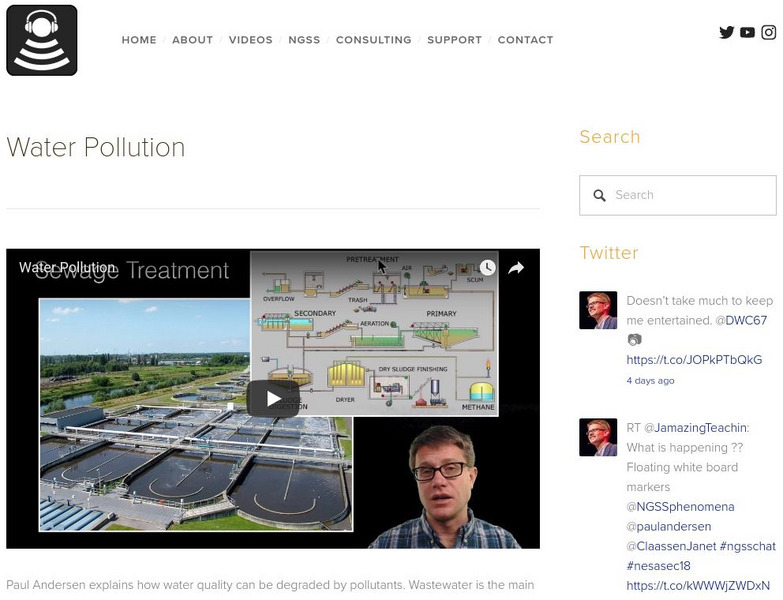TED-Ed
TED-Ed: Can the ocean run out of oxygen? | Kate Slabosky
For most of the year, the Gulf of Mexico is teeming with marine life, from tiny crustaceans to massive whales. But every summer, disaster strikes. Around May, animals begin to flee the area. And soon, creatures that can't swim or can't...
Bozeman Science
Water Pollution
In this video Paul Andersen explains how water quality can be degraded by pollutants. Wastewater is the main source of water pollution and can be measure using the BOD (biochemical oxygen demand). Dead zones, cultural eutrophication,...
Curated Video
How To Stop Your Poop From Killing Corals
Corals all over the world are threatened by warming ocean temperatures. But 30 years of data show that reefs off the Florida Keys could protect themselves from rising temperatures if they weren’t also dealing with nutrient pollution...
Curated Video
Eutrophication
An overabundance of nutrients in a body of water, causing excessive plant growth. A Twig Science Glossary Film. Key scientific terms defined in just 60 seconds using stunning images and concise textual definitions. Twig Science Glossary...
Curated Video
Pollution: Water
How does water get polluted? Discover what water pollution means for the environment and how it affects humans. Earth Science - Human Impacts - Learning Points. Industry, agriculture and sewage all contribute to water pollution....
Curated Video
यूट्रोफिकेशन | कृषि | जीवविज्ञान | FuseSchool Hindi
यह वीडियो यूट्रोफिकेशन की प्रक्रिया को समझाता है, जिसमें पोषक तत्वों के अत्यधिक बढ़ने से जल निकायों में शैवाल का तीव्र विकास होता है। यह शैवाल सूर्य की रोशनी को अवरुद्ध करता है, जिससे जलीय पौधों की मृत्यु होती है। शैवाल के मरने पर,...
EarthEcho International
Measuring Nitrates and Phosphates in Waterways to Prevent Dead Zones
In this video, a teacher and her student demonstrate how to test for nitrates and phosphates in water, which are major contributors to dead zones in waterways. They use equipment from Phosco to measure the levels of these nutrients in...
FuseSchool
What Is Water Pollution
Learn the basics about water pollution, whilst learning about environmental chemistry. The substances mankind throws away have polluted lakes, rivers and even the oceans. The United Nations estimate that around 10% of the world’s people...
FuseSchool
Modern Agriculture and Fishing
Intensive farming is beneficial to humans as it increases the availability of food and therefore increases food security. It produces higher yields more efficiently so it can be sold at cheaper prices. However, it is controversial...
FuseSchool
What Is Eutrophication
What happens when fertilisers get washed into lakes and rivers? A process called eutrophication. Learn all about it in this video. Eutrophication is the process that can happen in a water body, like a river or a lake, when too many...
EarthEcho International
Regenerating Marine Ecosystems: Agricultural Runoff and its Impact on the Everglades and Coral Reefs
Regenerating Marine Ecosystems part 1 of 2:
The video explores how agricultural runoff in the Florida Everglades is affecting downstream coral reefs and marine life. It highlights the importance of restoring the natural Everglades...
Fuse School
Environmental Impacts of Detergents
Dangerous detergents? Who knew? Pupils learn of the darker side of laundry day as they complete the series of seven videos on water and the environment. The video shows common detergent ingredients, how these ingredients can harm the...
Monterey Institute for Technology and Education
National Oceanic and Atmospheric Administration: Ocean Pollution
This learning module explores the effects trash, toxins, oil and sound pollution are having on our oceans. Includes two short videos along with a brief exploration and two interactives. A brief assessment follows each interactive.
Bozeman Science
Bozeman Science: Water Pollution
Paul Andersen explains how water quality can be degraded by pollutants. Wastewater is the main source of water pollution and can be measured using the BOD (biochemical oxygen demand). Dead zones, cultural eutrophication, disease, and...
Other
Atlas Pro: Eutrophication Explained
Explains what eutrophication is, what causes it, and the great harm it causes. [3:47]
NOAA
Noaa: Ocean Facts: What Is Eutrophication?
Explains what eutrophication is and the extent of the problem in the United States. Discusses the causes, impact, and what can be done to combat it. The video provides a short overview of the topic and is accompanied by a transcript. [1:04]





